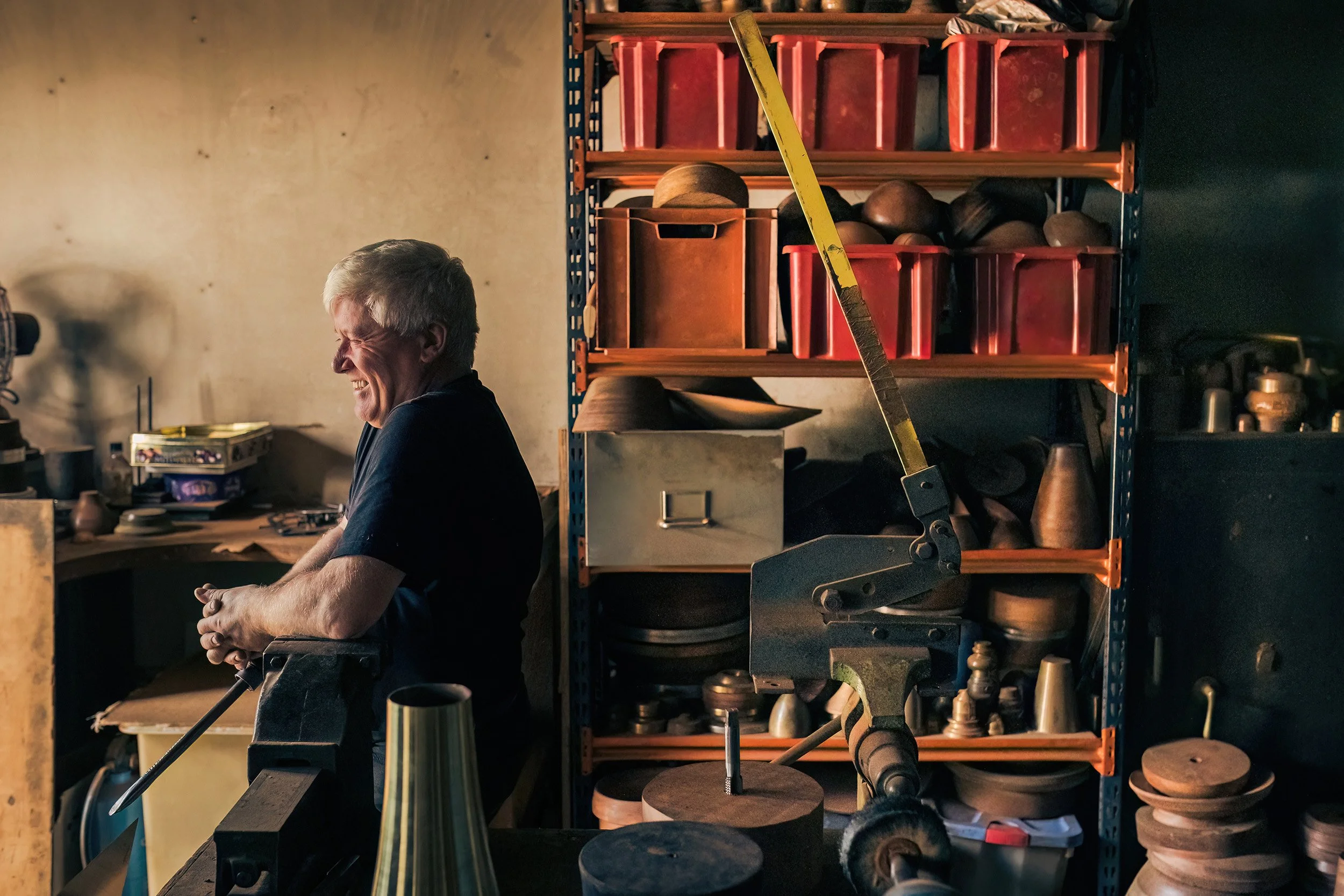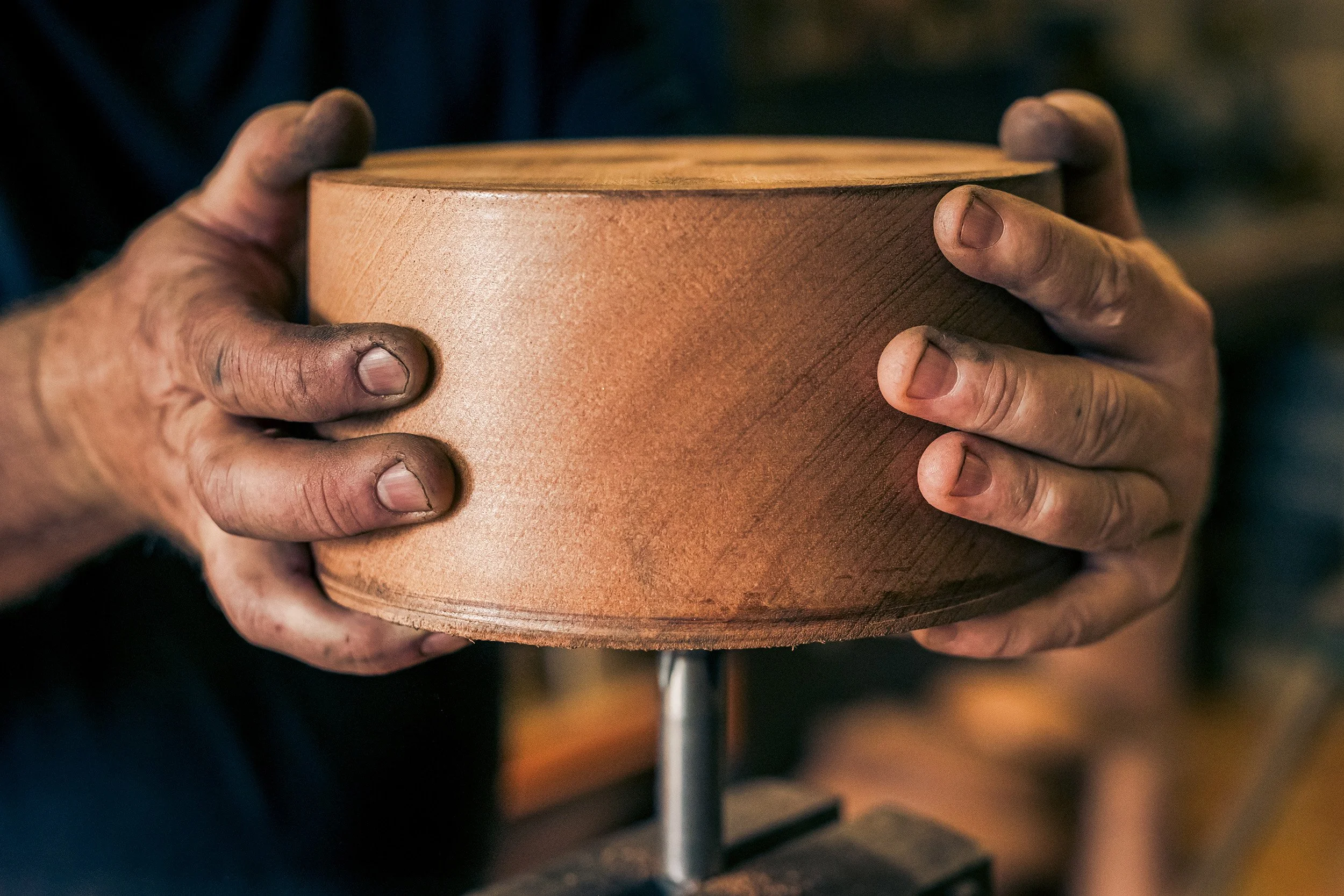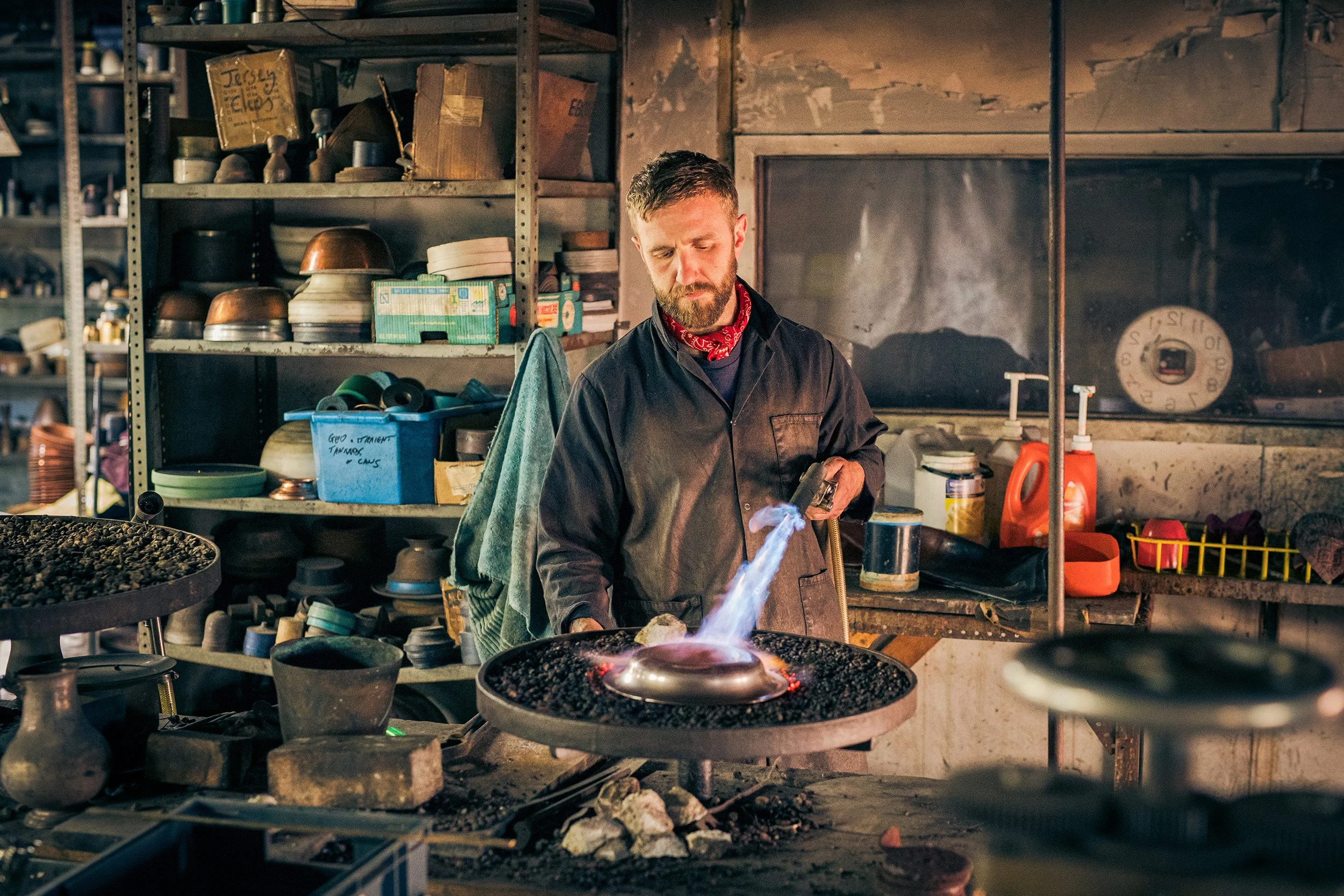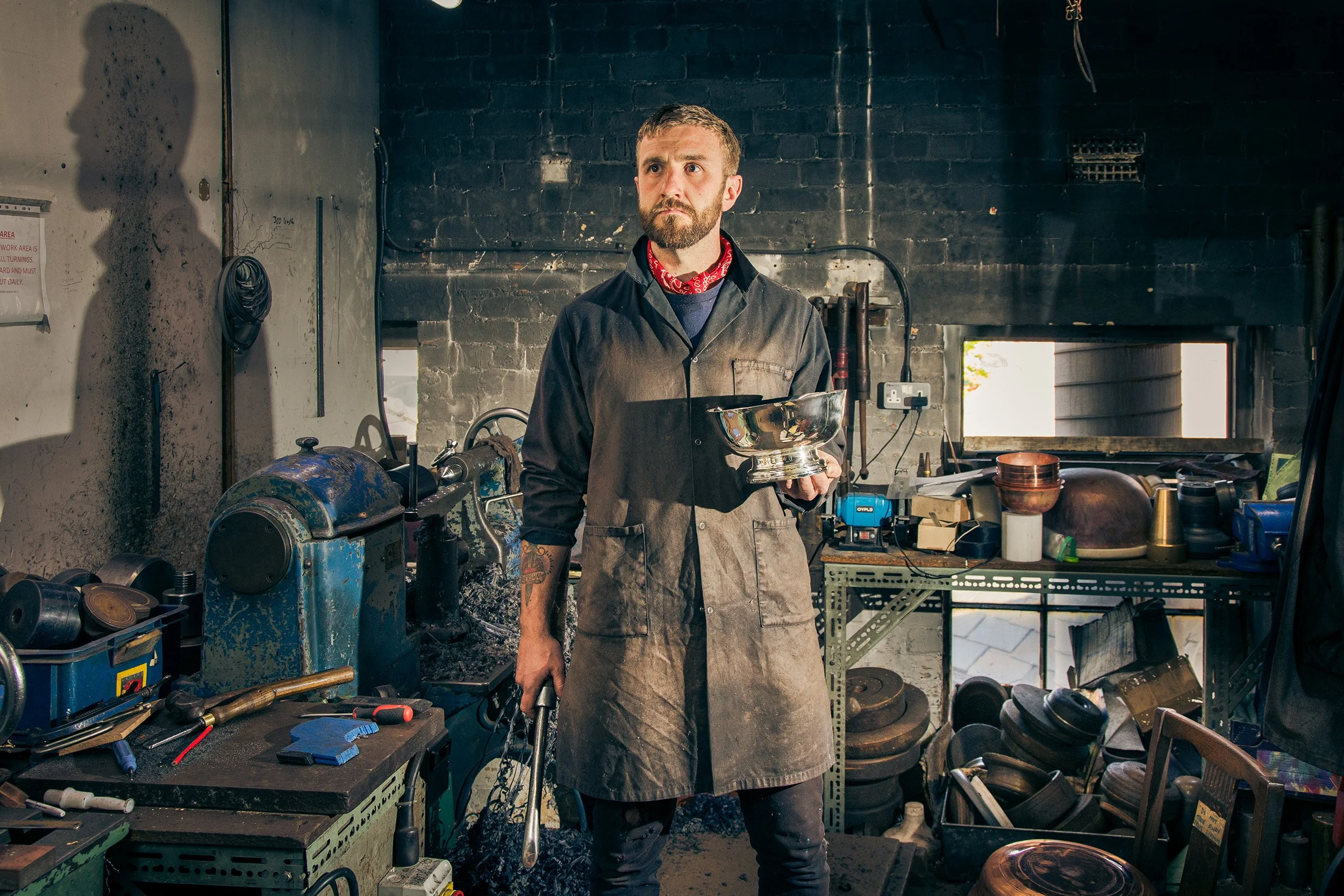The last turn of the lathe - The uncertain future of silver spinning
When he was sixteen, Stefan Coe was all set to study engineering at Brooklands Technical College in Surrey, when his Design Technology teacher, a trained silversmith, suggested he try silversmithing instead. Coe’s grandfather had been a metalsmith – a panel beater – so Coe applied for a yearlong apprenticeship funded by the Goldsmiths’ Company through the Sir John Cass School of Art and won one of two places. From there, he gained a further apprenticeship with Brian Fuller, a master silversmith who worked with the renowned Gerald Benney, thereby becoming part of a distinguished lineage. Three months into his apprenticeship, however, Coe was invited to choose whether he wanted to be indentured with Fuller as a silversmith, or with Fuller’s colleague Henry Pearce, whom Coe describes as “this old guy on a lathe”. Coe chose Pearce.
Pearce was a spinner. Trained as a silversmith, he had originally joined a company that lacked a spinner and so taught himself. Spinning is a technique that dates back to Ancient Egypt. Spinners shape a flat sheet of silver into a hollow form on a lathe, using a wooden, nylon, aluminium or steel former, known as a spinning chuck. It is, Coe testifies, a highly physical, highly precise, skilled craft. Spinning generates hollow forms that are uniform in thickness and symmetrical in form, with a smooth finish, in a fraction of the time it would take to achieve the same effect by hammering. The spun pieces can then be further worked to make trophies and other silver vessels, their surfaces chased, cut or enamelled, cutting down the time a silversmith needs to create their design. For Coe, it held instant appeal. “I found spinning intuitive and I was good at it,” he says. “Henry and I got on like a house on fire.”.
Today, Coe is one of Britain’s most highly regarded spinners. He works with both precious and base metals with leading silversmithing companies and myriad individual makers, including Peter Wilson for Theo Fennell, Clive Burr, and master enameller Fred Rich. But spinning itself is in crisis. Most spinners are over 70 years old, and Coe is one of just eight full-time spinners known to still be active in the UK, with five others working part-time. The craft has recently been moved from the Heritage Crafts Critically Endangered List to its Red List.
The challenges are manifold. “We don’t have very good data, but we know that there is a skills shortage and ageing practitioners,” says Mary Lewis, executive director of Heritage Crafts. This matters because spinning is one of the essential allied trades – alongside plating, polishing, buffing, finishing and engraving – which lie invisibly behind the prestigious craft of silversmithing. “Silver spinners hold up the entire silverware industry,” explains Warren Martin, who won the Heritage Crafts Precious Metalworker of the Year Award in 2024 for his contributions to the craft.
“Nearly all silverware produced by the trade is now spun. Without spinners’ production, silversmiths have nothing to assemble, buffers have nothing to buff, polishers have nothing to polish, chasers have nothing to chase, engravers have nothing to engrave.” Based in Sheffield, Warren is one of only two spinners under the age of 50 in the UK. “If we don’t spin the work, other craftsmen don’t have jobs,” he adds. “There is no other metal forming technique that can compete in a bespoke, one-off market.”
With a collapse in demand for silversmithing and rising competition from overseas, British companies can no longer afford to employ silver spinners or pay for their training. As Coe comments, in the 1960s and 1970s, when British silversmithing flourished, well-known companies such as Asprey or Garrard might have employed 50 or 60 silversmiths at the bench, supplied by one or two spinners. Even in the 1980s, 1990s and early 2000s, he explains, a lucrative Middle Eastern market made it financially viable to train spinners.
But 20 years later, Coe says that “even the largest company has only eight to ten people at the bench.” Many spinners have been forced to go freelance, working for multiple small companies or individual makers and creating in small batches, with tiny margins that would make training an apprentice, even with support from the Goldsmiths’ Company or other bodies, financially ruinous.
Coe was lucky. Pearce was at the end of his career and was prepared to allow his apprentice to simply observe him at work in the mornings, before teaching him in the afternoons. This radically reduced Pearce’s own productivity, while teaching added further costs.
“If [spinning] goes wrong, you can’t put it right, because of the speed of the procedure,” Coe says. “You have to start again.” Whereas a skilled silversmith can hammer out the errors of an apprentice raiser, a sheet of metal damaged in spinning has to be completely recycled. Training is also time consuming. "I can show anyone the basic principles of silver spinning in a short course but to learn the craft takes many years of practise." Martin says. "Because it is a full body process the way you spin is dictated by your physical build which is why no two spinners spin in exactly the same way. I am only really starting to master the craft now, after over 40 hours a week of spinning for well over a decade."
Coe has also observed that “people who go to university to study jewellery or silversmithing don’t want to come into trade,” as most students wish to pursue the more creative path of a designer-maker instead. But Martin did choose spinning. After his Metalwork and Jewellery Design course at Sheffield Hallam University, he undertook a dual apprenticeship at British Silverware in silversmithing and spinning. “I liked the immediacy of silver spinning. It is very like pottery,” he says. “I love the fluidity of the material, and seeing other shapes emerge as you go along.” He partly blames the decline of mainstream British silversmithing on a failure to update designs. “Many pieces produced in the trade are reproductions of designs which are hundreds of years old like Elizabethan dishes, Revere bowls and Georgian tankards”.
But there is hope. Lewis reports that the Heritage Crafts Association receives many enquiries from people looking for skills-based training. There are also ongoing conversations between the various sector bodies and the government about how to fund and structure apprenticeships. Angela Cork, the principal of Bishopsland Educational Trust, an organisation that is focused on silversmithing, reports that the trust is buying a second-hand lathe for its new campus in Oxfordshire and has already acquired “a wonderful collection of spinning chucks from David Alison, a retiring spinner based in Sheffield.” The team are also planning staff training to ensure Bishopsland can become “a centre for spinning, offering hands-on training and workshops led by expert practitioners, and creating teaching aids to spark interest and pass on crucial knowledge to the next generation.”
Cork has taken advice from Stuart Ray, a leading spinner based in Kent. Ray has been able to expand his business and take on a full-time apprentice supported by the Goldsmiths’ Company, Varis Prieditis, who was the winner of the Bronze Award for Polishing in the Goldsmiths Craft and Design Council Awards in 2019. Ray remembers beginning his own apprenticeship in 1990, only for the company who hired him to go into liquidation two years later. “All the patterns and tools went to Malaysia,” he says. Nevertheless, Ray persisted with different masters before setting up his own company 15 years ago. Now he runs a highly successful business supplying trophies – including the remade FA Cup in 2014 and the Six Nations Cup in 2015 – to companies such as Asprey, Garrard, Theo Fennell, Thomas Lyte and others. He also does a fair amount of teaching. “It is hard work,” he says. “We move from left to right with the metal. The lathe does not do the work – you have to ease it, to feel the metal.”
One maker who appreciates the work spinners do is silversmith and jeweller Jessica Jue. “Rather than starting with a flat sheet, I will get something spun into a simple form,” she says, describing the process behind some of her pieces. “You have to be very clear with your notes and sketches. It is a very different way of working from my usual fluid, organic, in the moment artistry.” Jue works with Coe, as does artist and metalsmith Adi Toch, who finds that the symmetry of a spun form can sometimes aid her process. Although she took a spinning course at The Cass many years ago, she was drawn more to hand-raising in her own practice. However, working closely with Coe on some projects has opened space for creative release. “Working with Stefan, whose spinning maintains an even gauge throughout and a refined surface, helps me achieve accuracy of form and can make a difference to the way I explore and experiment with new ideas.”
If spinning declines further, it will not just be Toch, Rich and Jue mourning the loss, but future generations of makers who will lose immediate access to this subtle and ancient technology
This Goldsmiths’ Story was written by Emma Crichton-Miller and first appeared in the Goldsmiths’ Review 2024-25 | Photography by Paul Read


















